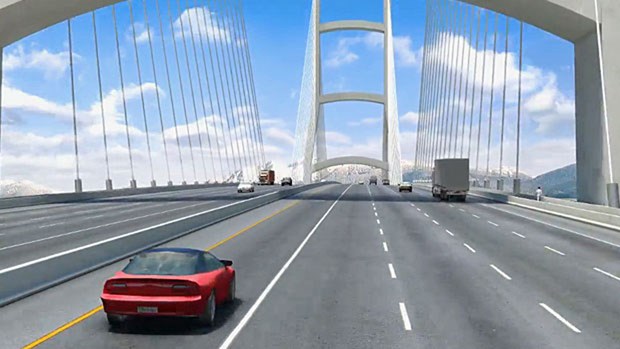A new bridge replacing the George Massey Tunnel will not merely shift the commuter bottleneck further along Highway 99 to the foot of the Oak Street Bridge.
According to Geoff Freer, executive project director for the George Massey Tunnel Replacement Project, a new link over the South Arm of the Fraser River will better address commuter patterns that have shifted in the past decade or so.
“What we’re finding today, and this is really a change in the last 10 to 15 years, more than 60 per cent of the traffic using the tunnel today is travelling between Richmond, Delta, Surrey and the U.S. border,” said Freer, who has also guided development of the South
Fraser Perimeter Road, which is scheduled to be completed this December.
He added the shift is due, in part, to the growth in jobs at YVR, and a general increase in economic activity in the immediate region encompassing Surrey, Richmond and Delta.
“YVR has somewhere in the neighbourhood of 25,000 employees. If you look at the development in Richmond, the business parks, the port activity up the river, there has been a lot of changes.”
The bridge project, announced last Friday by Premier Christy Clark, has come under fire from a host of political leaders in the region, especially Richmond Mayor Malcolm Brodie who was concerned a new span would just simply move one of the Lower Mainland’s worst choke points and not solve the daily commuter crush he feels could be addressed by better transit links.
But the bridge project’s Freer said the route already has decent public transit ridership.
“In the morning rush, for example, more than 50 per cent of those commuters going to Downtown Vancouver use transit already,” he said. “That’s a very high number. And overall, 26 per cent of the people using the tunnel, use transit.
“I think that’s in part due to the rapid bus lanes, queue-jumpers and probably the Canada Line helps with that, too,” he added.
And look for a boost for public transit with a new bridge, Freer said.
“We definitely will have a dedicated lane for transit. That’s what we do these days. That will be a big benefit, in terms of transit.”
Overall, the new bridge is not strictly about addressing the Oak Street and Knight Street Bridges anymore, Freer said.
“It’s really about how do we make improvements to help traffic using the tunnel, the majority of which is going between Richmond, Surrey, Delta, and the U.S. border,” he said.
“That’s a change a lot of people don’t realize has happened. And we have been talking to municipal staff in Richmond and Delta over the past year and will continue to work with them in order to see what things need to be done along the corridor. We’re looking at the corridor itself, from the (Canada-U.S.) border, to Bridgeport Road, and where can we make improvements at the interchanges.”
Richmond Mayor Malcolm Brodie isn’t sold on the explanation, pointing to the current, chronic congestion during peak travel times at the Oak Street Bridge.
“That lineup is the proof that’s in the pudding,” Brodie said. “And it’s not just a matter of building on-ramps and off-ramps to reduce congestion along that strip of highway.”



